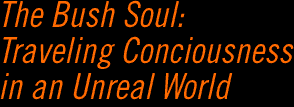
Rebecca Allen
We are told that in the not so distant future we will spend hours immersed in three dimensional virtual worlds. These worlds will include "avatars", virtual representations of ourselves in the form of computer generated characters. Our soul, our consciousness, will somehow be embodied in an avatar. The avatar becomes our other body, another container for our spirit.
What is the relationship one has with his or her avatar? Do we control it like a puppet, or is an avatar like a child, containing the spirit of its parents but with its own set of behaviors? What part of "us" is in our avatar? Is part of our soul in this computer generated character?
The psychologist C.A. Meier, equates the soul to our most intimate identity, our conscious ego (Meier 1986). When writing about the localization of consciousness Meier refers to the observations of Mary Kingsley, an ethnologist who lived with West African tribes in the 1890's.
Kingsley stated that the West Africans believe that a person has more than one soul and that there is a certain type of soul, called the "bush soul", that dwells within a wild animal of the bush. A person's bush soul lives inside an animal though that animal also has a life of its own (Kingsley 1899).
An avatar could serve as a place for the bush soul; following the guidance of the person attached to it, but "alive" with is own set of behaviors. I am leading a research project that is exploring the role of the avatar and other issues of aesthetics in cyberspace design. We are building a PC-based system, called "Emergence", that will support an active, responsive, networked, virtual world.
Environments and their inhabitants are rendered in real-time as three dimensional, texture-mapped polygons. The users (called "participants") are represented as avatar models. The virtual inhabitants' unique behavior emerge from a set of parameters. In the case of the avatar, its behavior is combined with input from the participant.
We are experimenting with forms of communication that rely on symbolic gestures, movements and behaviors. Our focus is on motion, the "life" of the environment, and the role of artificial life in the creation of an art form which includes the interactive experience.
Many cultures believe that everything has some form of a soul. We carry this idea into our virtual world where every object is instilled with some form of artificial life. Driven by its internal code or in response to its environment, an object may change its shape and color, make a sound or begin to move.
In our virtual world relationships can be formed between all elements. Movement and interaction enhance the emergence of a rich environment populated by engaging inhabitants. An intriguing place for a traveling bush soul.
(This work, titled "The Bush Soul", is funded by a grant from Intel Corporation.)
Kingsley, Mary 1899. West African Studies. London: Macmillan and Co., pp. 199-209.
Meier, C.A. 1986. Soul and Body. San Francisco: The Lapis Press, pp. 268-277.